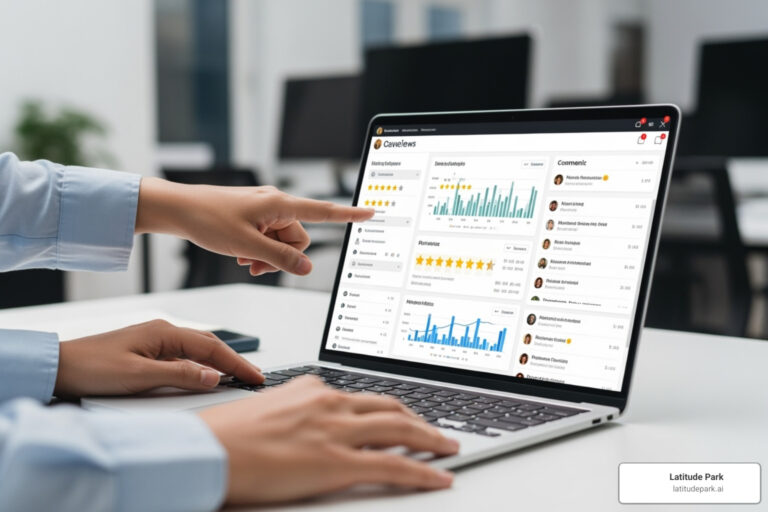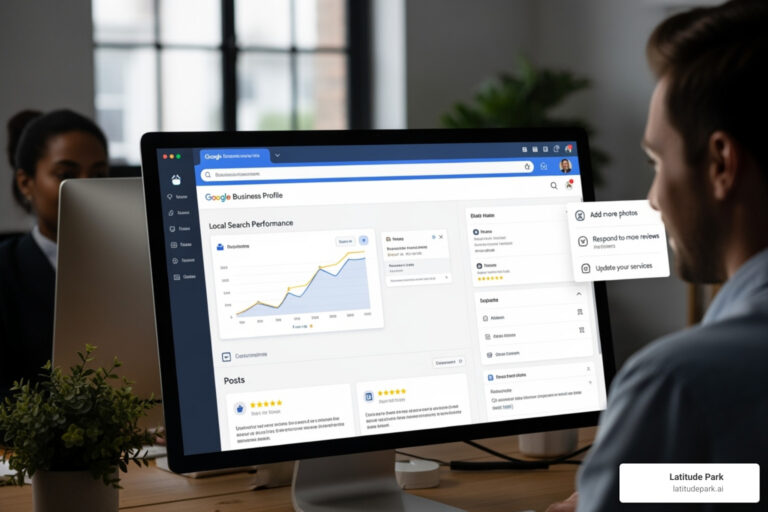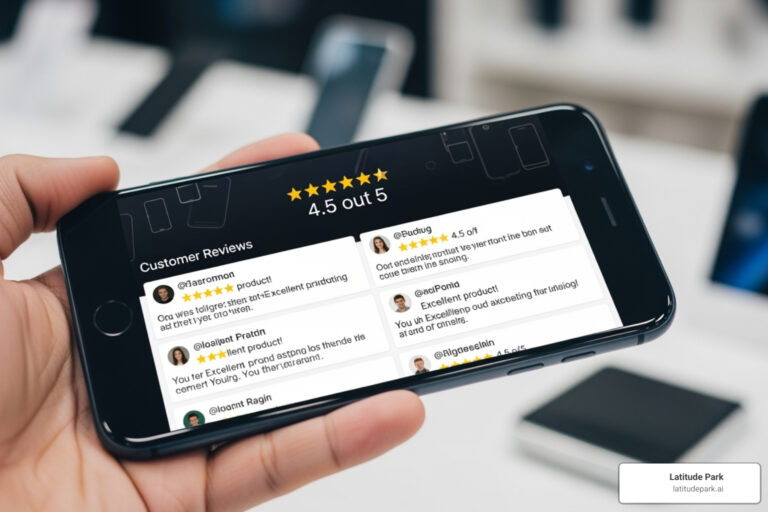Measuring digital marketing success isn't just about chasing numbers that look good on a report, like website visits or social media likes. It’s about connecting your marketing actions directly to real business outcomes. The real goal is to prove your value by focusing on the metrics that actually matter: revenue growth, customer loyalty, and a stronger foothold in your market.
Beyond Vanity Metrics: What Success Really Looks Like
Let's be honest. It's easy to get caught up celebrating metrics that feel good but don't tell the full story. A big spike in website traffic is exciting, but what if none of those visitors are your ideal customers? True success in digital marketing comes when you can draw a straight line from your efforts to tangible business results. For instance, a local plumbing company might see a surge in traffic from a viral TikTok video, but if that traffic is from teenagers across the country, it's not a business win.
This takes a shift in mindset. Instead of just counting impressions, we need to start asking better questions.
- Did that traffic actually turn into qualified leads?
- Are our social media followers engaging in meaningful ways?
- Are we building a loyal community that keeps coming back for more?
Answering these is the heart of effective digital marketing measurement. The industry is thankfully moving away from old-school metrics like raw clicks and views. The new focus is on relationship and engagement KPIs—things like brand sentiment, community interaction, and genuine customer connections.
The real goal isn't just more leads; it's better leads. Success means attracting prospects who are more likely to become long-term, valuable customers for your business.
To get a clearer picture of what success looks like, it helps to break it down. Understanding frameworks for specific areas, like figuring out how to measure content marketing success, offers a much deeper and more focused perspective.
To give you a quick overview, here’s a look at the core pillars you should be thinking about.
Key Pillars of Digital Marketing Measurement
| Measurement Pillar | Key Metrics | Business Question Answered |
|---|---|---|
| Traffic & Reach | Unique Visitors, Traffic Sources, Bounce Rate | Are we attracting the right audience to our digital properties? |
| Lead Generation | Conversion Rate, Cost Per Lead (CPL), MQLs | Are our marketing efforts generating potential customers effectively? |
| Customer Engagement | Social Media Engagement, Email Open/Click Rates, Time on Page | Is our content resonating and building a relationship with our audience? |
| Revenue & ROI | Customer Acquisition Cost (CAC), Return on Ad Spend (ROAS), CLV | Is our marketing driving profitable growth for the business? |
This table provides a simple roadmap for connecting your daily marketing tasks to the high-level results your leadership team cares about.
Ultimately, you need a clear framework that ties every single campaign back to core business objectives. This means evaluating traffic quality, tracking lead generation, monitoring customer engagement, and—most importantly—measuring the final impact on your bottom line.
Analyzing Your Website Traffic and Audience Quality
Getting more visitors to your website feels like a win, and it is. But it’s only half the story. The real question isn't just "How many visitors did we get?" but rather, "Are these the right visitors?"
Not all traffic is created equal, and figuring out the quality of your audience is where the real work—and the real success—begins. This is where you stop obsessing over sheer volume and start digging into what the data is telling you about the people behind the clicks.
Pinpointing Your Highest-Value Traffic Sources
Let's imagine a real-world scenario. A B2B software company is running two campaigns: one on LinkedIn targeting specific job titles, and another, broader campaign on Facebook aimed at general business interests.
The Facebook ad might bring in a flood of clicks, which looks great on a surface-level report. But a quick look inside Google Analytics 4 (GA4) could show that visitors from LinkedIn spend twice as long on the site and are 30% more likely to book a demo.
That’s the kind of insight that moves your marketing from a guessing game to a data-driven strategy. It tells you exactly where your most engaged—and most profitable—audience is coming from.
For instance, this GA4 traffic acquisition report below clearly shows which channels are bringing in new users.

You can see that Organic Search and Direct traffic are the top dogs here, which immediately highlights the value of solid SEO and strong brand recognition. This data is a green light to double down on what's working—like creating more helpful blog content—and pull back on channels that deliver clicks but no real value.
To sharpen your digital marketing strategy, you might find some useful ideas in our guide on 9 effective digital marketing tips for businesses.
Don't just celebrate more visitors; celebrate the right ones. High-quality traffic from a specific, targeted channel will almost always outperform massive volume from a source that's hitting the wrong audience.
By diving into user behavior metrics like session duration, pages per session, and bounce rate for each traffic source, you build a clear picture of who's actually interested. A low session duration from a paid ad campaign is a red flag that your ad message and landing page are misaligned. High engagement, on the other hand, is the confirmation you need that you're attracting the right crowd.
Tracking Conversions And High-Value Leads
Lots of traffic is nice, but it doesn't pay the bills. The real magic happens when your marketing efforts translate into tangible business results, turning curious visitors into committed customers. This is where we stop counting eyeballs and start counting actions.
Not all actions are created equal, though. I always tell my clients to track both macro-conversions (the ultimate prize, like a product purchase or a signed contract) and micro-conversions (smaller steps that signal interest, like a newsletter signup or a "how-to" guide download). Think of these smaller steps as breadcrumbs—vital clues that a visitor is getting serious and moving down your sales funnel.

Differentiating Lead Quality
The goal isn't just more leads; it's about attracting better, more qualified leads. For instance, a B2B SaaS company needs to know who’s just browsing and who's ready to talk business. This is how you focus your sales team's precious time.
- Marketing Qualified Lead (MQL): This is someone who downloads a top-of-funnel whitepaper on "Industry Trends." They're interested in the topic, sure, but probably not ready to pull out their credit card.
- Sales Qualified Lead (SQL): This is the person who hits your pricing page and then requests a personalized demo. That's a strong buying signal indicating immediate interest.
When you track these separately, your marketing team can keep nurturing the MQLs with more great content, while your sales team can jump on those high-value SQLs right away. If you're looking for ways to boost these numbers, our guide on over 30 ways to increase conversions on your website has some great, practical tips.
Calculating Your Cost Per Acquisition
Knowing a lead is good is only half the battle. You also need to know if acquiring them is actually profitable. This is where Cost Per Acquisition (CPA) comes in, and it's one of the most important numbers in your entire marketing toolkit. CPA tells you exactly what you spent to get one new paying customer from a specific campaign.
The math is simple: Total Campaign Cost / Number of New Customers Acquired. For example, if a company spends $1,000 on a Google Ads campaign and gets 10 new customers, their CPA is $100. If each customer is worth $500, that's a fantastic return.
A low CPA means your marketing is efficient and profitable. A high CPA is a fire alarm—a clear signal that you need to rethink your strategy, targeting, or messaging before you burn through your budget.
Ultimately, your conversion metrics tell the real story of your marketing's effectiveness. They show how well a campaign turns visitors into leads or customers. As businesses get smarter about their spending, the focus has shifted from lead quantity to lead quality—finding those prospects who are most likely to convert. You can even dig into specific tactics and find out whether live chat increases conversions to see how a single tool can directly impact your lead generation.
Measuring Audience Engagement and Brand Loyalty
In a marketplace overflowing with noise, an engaged audience isn't just a nice-to-have; it's your single most valuable asset. The real story of your brand's health isn't told by surface-level stats like follower counts. It's found in the metrics that signal a strong, loyal customer relationship.
It's one thing to get eyeballs on your site, but it's another thing entirely to make people actually care. A great place to start digging is with your on-site engagement signals. Metrics like scroll depth (how far people bother to read down a page) and repeat visitor rates tell you if your content is genuinely hitting the mark. A high repeat visitor rate is a fantastic sign that you're creating something valuable enough for people to come back for more.
Look Beyond Likes and Follows
The same principle applies to social media. Sure, likes feel good, but they don't pay the bills. You need to focus on the deeper signals that show your audience is actively participating with your brand, not just passively scrolling past.
What should you be looking for?
- Comment Sentiment: Are the comments on your posts genuinely positive and excited? Or are they just neutral or, even worse, negative? Tools can analyze this for you at scale, giving you a real-time pulse on how people feel about your brand.
- Direct Message Inquiries: This is a big one. When someone takes the time to slide into your DMs to ask about your products or services, that's a high-intent signal. It shows they trust your brand enough to start a private, one-on-one conversation. For a retail brand, this could be a question like, "Do you have this in a size medium?" which is a clear buying signal.
A single, thoughtful question in a comment or DM is often more valuable than a hundred passive likes. It represents a user who is actively considering what you have to offer and moving closer to a conversion.
I saw this play out perfectly with an e-commerce store I worked with. They started tracking repeat purchase rates and Customer Lifetime Value (CLV), but specifically for customers who came through their email nurture sequences. The results were staggering. They discovered that nurtured subscribers had a 45% higher CLV compared to customers from any other channel. It was definitive proof of the massive ROI that comes from building a loyal, engaged community.
Ultimately, learning how content marketing campaigns can benefit your business is tied directly to measuring these loyalty-building interactions. If you want to turn followers into true brand advocates, a deep dive into understanding content engagement metrics is essential for proving your efforts are making a real impact.
Tying Your Marketing Directly to Revenue and ROI
This is where the rubber meets the road. It's the moment you draw a straight line from your marketing campaigns to your company's bottom line. Calculating your Return on Investment (ROI) and attributing revenue back to specific marketing activities are how you prove your department's value and make a rock-solid case for your budget.
Frankly, it’s the ultimate scoreboard for digital marketing success.
The basic formula for ROI is refreshingly simple: ((Revenue from Marketing – Marketing Cost) / Marketing Cost) x 100. A positive ROI isn't just a good sign; it proves your marketing is a profit center, not just another expense on the books.
Let's imagine a software company invests $5,000 in a content marketing program. By tracking the leads that came from their blog, they can pinpoint 10 new customers who brought in $20,000 in revenue.
Their ROI? A whopping 300%. That single number—((20,000 – 5,000) / 5,000) x 100—speaks volumes and powerfully communicates the program's value to any stakeholder, from the CFO to the CEO.
Choosing the Right Attribution Model
Attribution is simply the process of giving credit where credit is due. Which marketing touchpoints actually led to a sale? Without a clear attribution model, you’re essentially guessing which of your channels are pulling their weight. The model you choose should be a direct reflection of your business goals and the typical length of your sales cycle.
- First-Touch Attribution: This model gives 100% of the credit to the very first interaction a customer had with your brand, like an initial click on a social media ad. It’s perfect for understanding what’s driving top-of-funnel awareness.
- Last-Touch Attribution: As the name suggests, this is the polar opposite of first-touch. It gives all the credit to the final interaction before a conversion, like a click on a branded Google search ad. This is incredibly useful for figuring out what finally convinces people to buy.
- Multi-Touch (Linear) Attribution: This approach spreads the credit evenly across every touchpoint in the customer's journey. It provides a more balanced perspective, acknowledging that it often takes multiple interactions to influence a final decision. For example, a customer might see a Facebook ad (touch 1), read a blog post (touch 2), and then click an email link (touch 3) before buying. A linear model gives each of these 33.3% credit.
Deciding on an attribution model isn't just a technical task; it's a deeply strategic one. Your choice directly shapes how you value each channel and, as a result, where you decide to invest your marketing dollars in the future.
The infographic below illustrates how different metrics, like those from social media, all feed into the bigger picture of engagement that attribution models help you decipher.

Visualizing this data helps connect high-level activities, like managing your social media, to the broader customer journey that you’re trying to track and understand.
To help you decide which model is the right fit, it’s helpful to see them side-by-side.
Attribution Model Comparison
This table breaks down the most common attribution models to help you match a model to your specific business goals.
| Attribution Model | How It Works | Best For |
|---|---|---|
| First-Touch | 100% of credit goes to the first marketing touchpoint. | Businesses focused on lead generation and understanding top-of-funnel awareness. |
| Last-Touch | 100% of credit goes to the final touchpoint before conversion. | Companies with short sales cycles or those wanting to know what closes deals. |
| Linear | Credit is distributed evenly across all touchpoints. | Brands with longer sales cycles that want a balanced view of the entire customer journey. |
| Time-Decay | More credit is given to touchpoints closer to the conversion. | B2B companies or those with a considered purchase process where recent interactions are key. |
Ultimately, there's no single "best" model for everyone. A company selling t-shirts online might find a last-touch model gives them all the clarity they need. On the other hand, a business selling high-ticket software—a long, complex customer journey—will likely get far more accurate insights from a multi-touch approach.
When you can confidently explain which channels contribute at each stage of the journey, you're empowered to have much more meaningful and strategic conversations about budget and direction with your leadership team.
Common Questions About Marketing Measurement
Even with the best framework in place, you’re going to run into questions once you start digging into the data. Let’s tackle some of the most common hurdles I see marketers face and get you moving forward with confidence.
What if I Have a Limited Budget for Tools?
You don’t need a pricey software subscription to get started. In fact, you can get incredibly far with free tools.
Google Analytics 4 (GA4) is a powerhouse, and it’s completely free. It can answer most of your big questions about website traffic, how people are using your site, and where your conversions are coming from. Pair that with the built-in analytics from your social media platforms, and you’ve got a solid foundation without spending a dime.
For example, a small e-commerce store can use GA4 to see which products get the most views and set up conversion goals for every sale. That’s mission-critical data, and it costs nothing.
How Do I Handle Stakeholders Fixated on Vanity Metrics?
Ah, the classic challenge. You’re not alone. The key is to reframe the conversation and connect the dots for them, moving from "what happened" to "so what?"
Instead of just showing off 10,000 new followers, you need to tell the rest of the story.
Tie the vanity metric directly to a real business outcome. You could say, "Yes, we gained 10,000 followers this month. Even better, that led to a 15% increase in website traffic from social media, which generated 25 qualified leads for the sales team."
This approach acknowledges the number they’re excited about but immediately pivots to the results that truly impact the bottom line. You're not dismissing their metric; you're educating them on its real value.
Where Do I Start with Limited Data?
If you’re starting from ground zero, don't let analysis paralysis stop you. Just start tracking a few essential things.
The first step is simply to get your GA4 tracking code installed. Then, set up one or two straightforward conversion goals—something like a "Contact Us" form submission or a signup for your email newsletter.
Focus on just collecting baseline data for the first 30-60 days. This initial information won't be perfect, but it gives you a benchmark. From there, every decision you make will be smarter and more informed because it’s based on real behavior, not just guesswork.
Ready to stop guessing and start getting real results from your marketing? The team at Latitude Park specializes in running targeted meta ads, Google ads, and SEO for franchises and small businesses. Let us show you how to connect your marketing directly to your bottom line. Find out more about how we can help your business grow.









